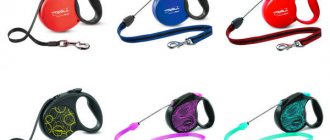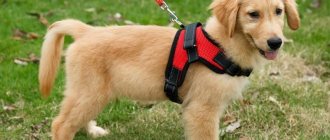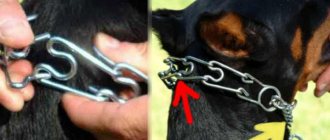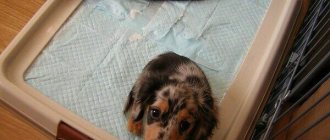Most inexperienced dog owners ask a lot of questions in the first months of having a puppy.
One of these questions is how to train a puppy to use a leash and collar. After reading this article, which describes the rules of behavior for the owner and the organization of training for the puppy, you will know the answer to this question. If you buy a dog from a kennel or from trusted breeders with experience, there is a high probability that he has already been accustomed to a small first collar. This is so because breeders use colorful strings or ribbons to mark the puppies.
How to accustom a puppy to a collar
One of the first questions that owners ask after purchasing a pet is “How to accustom a puppy to a collar?” If we are talking about a very small puppy, then this will not be difficult to do, but if you purchased or adopted from a shelter an almost adult dog that sees such equipment for the first time, you will have to tinker. One way or another, let's look in detail at what age to accustom a puppy to a collar and how to do it correctly.
When can you put a collar on a puppy?
Most breeders place collars on puppies as early as one week of age. This is done because it is convenient to put an individual mark on the collar, which will allow the kids not to be confused with each other. Typically, breeders make the first collars themselves, using braid or suede, and sew on a button to secure them. Store-bought collars with buckles are not suitable for very small puppies. The fact is that puppies will fiddle with, chew and pull the free ends of the collar of their brothers, the buckle often unfastens, the collar turns into a loop and the puppy can simply be strangled. In general, it is unacceptable for the collar to put pressure on the neck; it should be quite loose. For adult dogs, it is considered normal for two fingers to fit freely under the collar.
Usually a puppy is taken home from the breeder at 2-3 months. At this age, it is already acceptable to wear a collar with a buckle, so as soon as the pet gets comfortable in its new home, you can purchase a collar that fits the size and begin training it. As for when to put a collar on a puppy who is more than six months old, the answer is the same - as soon as the dog gets at least a little accustomed to the new place.
Therapeutic effect of the collar
As you know, collars perform not only an aesthetic function, but also a healing one. They allow you to get rid of parasites such as ticks and fleas.
This collar is a manufactured strip containing antiparasitic components. However, puppies should not choose products that are intended for adults. Such products can cause allergies and worsen the overall health of the baby. Manufacturers took this fact into account and today protective products are arriving on the shelves of specialized stores. They are specially designed for puppies up to six months old. In most cases, these types of products do not have a specific odor.
When to wear a collar
For service dogs, the collar is practically part of the body; they wear it constantly. For hunters, on the contrary, it is unnecessary - during a hunt, the collar can get caught on a branch, and then you will be exhausted looking for the stuck dog. As for ordinary pets, they need it primarily so that they have something to attach the leash to. Also, an address tag with the dog’s name and the owner’s contact information is often hung on the collar , so that if the dog is lost, the dog can always be returned home.
No matter how obedient your pet is, do not take him for a walk without the appropriate equipment. Walking your dog in the city without a collar or harness is extremely risky!
When should you put a collar on your puppy?
Cynology post pinned
When should you put a collar on your puppy for the first time?
At any time, even on the very first day, since it is always better to hold the puppy by the collar than to pull his fur or skin with your hands. A collar and leash scare the puppy less.
Your puppy's first collar should be lightweight, made of fabric (easy to wash), safe (no small metal parts that the puppy could swallow), and with a quick fastener.
I usually sew the puppy’s first collar myself. I take a silk ribbon of the required length, sew an improvised button on one end (the remains of the same ribbon, folded several times), and make a loop on the other side. If a puppy takes off such a collar, it can chew it into small pieces, but will not harm itself.
The puppy wears this ribbon collar for 3-5 days, after which it stops scratching and generally stops paying attention to the collar. Then you can wear a real collar from the store.
If the puppy is older than 3 months and he is afraid of the collar, you will need to specially train him
There is one important rule that must always be followed:
When the puppy is left at home unattended, take everything off him!
Otherwise, the puppy, out of habit, may get its paw under the collar and not be able to get out, injuring itself.
Source
Collar for a puppy: making the right choice
Every person who decides to get a puppy must firmly understand their responsibility to the animal and to society.
Many people think that raising a pet is not worth spending a lot of time on, but this is not true. You are lucky if the animal spent the first months of its life with a breeder who raises the baby from the first weeks of life, however, this does not always happen.
The first thing a new owner of a puppy faces is walking. Then the first and most important questions begin. The animal is not accustomed to the collar. How to deal with this situation and how to be able to accustom a dog to it will be discussed in this material.
FAQ
How to stop a dog from chewing on a leash?
To wean your animal from this bad habit, you can smear the strap with a substance that is unpleasant for the animal: salt, pepper, etc. The dog’s taste buds will receive a negative signal, and he will no longer chew on the device.
Why does a dog not like a leash and what to do about it?
The animal does not like the leash because the owner did not properly accustom him to the device, the training was irregular or was not supported by treats. Therefore, stable connections between training and treats were not developed.
How to accustom your pet to a collar
If you have adopted a dog that has never worn such a piece of equipment before, then patience will be required .
Probably, such a “collar” will not cause delight, so the owners use various tricks in order to distract the animal from the discomfort-causing accessory on the neck:
- Place the collar in front of the puppy and let him sniff it. But! Don't let it be treated as a toy or chewed on.
- Wait until your pet is hungry and then try putting it on . Afterwards, immediately give the animal food or a favorite toy so that it is distracted from the unfamiliar element on its neck. If it works, keep the dog on for 5-10 minutes, then remove it.
Repeat this trick several times a day for several days, each day increasing the time the animal spends in the accessory. Then the collar will evoke associations with play or food without causing inconvenience. After a few days (4-5, you need to look at the behavior), put the equipment on your pet and take him for a walk.
- If the puppy tries to remove an unpleasant object on his own, distract him and then carefully remove him .
- If the animal starts to panic and rush around, then you need to buy a harness or take treats for a walk to distract it. The training process can be quick , but if the animal does not understand the unnecessary elements on it, it is necessary to patiently continue training.
- If you are raising a service dog, keep it in a collar at all times . Ordinary pets can only wear it for a walk.
What to do if your dog doesn't like the leash
When teaching a puppy to walk on a leash, inexperienced owners make mistakes. They can be overly strict, and negative emotions are fixed in the dog’s mind, or, on the contrary, they feel sorry for the baby, which is why they do not show perseverance and perseverance. Discomfort due to incorrectly selected equipment can also discourage the puppy from any desire to walk on a leash.
Is your dog being naughty and refusing the leash? Check to see if one of the following is the cause:
- the collar is fastened too tightly, and, as a result, every step the dog takes is accompanied by pain and suffocation;
- the puppy was allowed to play with a leash, and now he perceives it as a toy and refuses to walk in it - buy a new one;
- they couldn’t restrain themselves and spanked the pet with a leash, and after that he refuses to walk on it - the use of force is unacceptable. Now slap the accessory on your knee and watch your pet’s reaction. If the puppy flattens his ears, he is afraid of the leash. A special vest-harness for puppies or a lighter leash will help;
- the puppy’s natural desire to play was completely ignored, he was only forced to walk next to him - do not forget about positive emotions! The dog can't wait to run and frolic. If you are going to combine a walk with the puppy and your own business, then the interests of the dog come first.
If you did everything correctly, but still couldn’t train your dog to use a leash, contact a dog trainer for help! Your future peace of mind and the safety of your pet depends on this.
Making the right choice
How to choose a collar for a puppy? An important factor when choosing a collar is size . It should not fit tightly to the animal’s neck, but it should not hang loosely on it either. The most optimal distance between the neck and him is two or three fingers, so that there is no pressure on the neck .
As the animal grows, the accessory must be changed. If the pet is small or medium in size, then you need a narrow piece of dog equipment; if it is large, you need a wide one. It should not be convex or have an uneven inner surface. Flat and light in weight – just what kids need.
Ideally, it is better to purchase both a collar and a harness (harness). On the first walks, if the dog tries to get ahead, the harness will not compress the airways. The harness should be made of braid.
If your pet is too active or shows aggression, buy a halter, but use it infrequently, only when walking.
The optimal leash length is 1.5-1.8 meters.
Which material is better
A puppy collar should be leather , consisting of several layers. And the clasp, ring, fastening are made only of steel. Check the quality of fastening immediately upon purchase.
Other materials and metals may cause irritation or an allergic reaction in the animal. Therefore, the collar should not contain alloys. Don’t go for cheap prices – your pet’s health is more important.
You can purchase collars both in pet stores and online stores. It is important to check the quality of the material and fastenings so that the baby does not run away.
Does it help?
When choosing between models with different principles of operation, many owners wonder which option is better, does a flea collar help dogs?
Since insects often die only after they bite, there remains the possibility of transmitting a dangerous infection to the dog. However, thanks to modern developments, the repellents with which protective products are impregnated not only kill bloodsuckers, but also repel them with a pungent odor. This reduces the risk of getting bitten. It should be understood that as the effectiveness of the toxins decreases, the effectiveness of the tape decreases and fleas can again attack the animal. Therefore, you should change the strap in a timely manner, in accordance with its expiration date.
At what age should a puppy be accustomed to a collar and leash?
Experts recommend introducing your pet to new objects for the first time at the age of one and a half months. Most likely, an unfamiliar thing on the neck will irritate the puppy at first, but the main thing is to show a little patience, do not punish, do not behave aggressively, and the efforts will be rewarded.
The training process, as a rule, begins at the age of three months, at which time you can accustom the baby to the toilet, his own place. However, it is impossible to go outside with a puppy without a collar and leash, which is why already at one and a half months they put a collar on the pet for the first time. The process of a baby’s adaptation to new objects is divided into several stages to make the task easier and not to traumatize the puppy’s psyche.
If your puppy has not yet been vaccinated or is not fully vaccinated, you can and should still walk him.
Stages of training
The sooner you start training your puppy, the easier it will be for you in the future.
It is not surprising that a pet's first acquaintance with new things causes protest, but this is a completely predictable reaction. To make the dog’s habituation process as easy as possible, experts recommend breaking it down into several stages.
Adaptation
It is necessary to remember that the issue will not be resolved in one day; regular practice will be required when the dog is calm or playing. A reward system should be introduced from day one. There are several reward options for a pet, each owner can choose the one that the puppy likes.
How to reward a puppy:
- Every time your puppy diligently follows your instructions, give him a treat.
- Surely the puppy has a favorite game, after the lesson with the collar - play with the pet.
- Clicker rewards are used to communicate with a dog without physical contact, in which case the owner praises the puppy through a beep.
Now the puppy should gradually get used to the collar. If your pet is nervous and tries to take off his new clothes, don’t worry, try to calm the dog down.
How to calm a puppy:
- Distract your pet with play.
- Reward your puppy every time he agrees to wear the collar.
- Check whether the puppy is comfortable in the collar; it should fit snugly to the neck, but not restrict movement.
A puppy can be at home wearing a collar only if someone is looking after him; if you leave and leave the pet alone, the collar must be removed.
Each puppy's attitude towards a leash is individual - some categorically do not want to be deprived of freedom of movement, while others do not even notice the new object. In any case, the first time you attach the leash to the collar, throw the free edge and let the puppy run around and understand that the new object is not dangerous. During the first days, be sure to make sure that the leash does not entangle the puppy while playing and running. Give your dog a treat each time you remove the leash.
Leash training outdoors
As soon as the puppy begins to walk calmly in his harness at home, on average it will take four days, try going outside with your pet. What nuances should you consider when going for a walk for the first time with a collar?
KEEP CALM
Very often, dogs that calmly respond to a leash at home, on the street begin to behave completely differently - they whine, bark, do not want to walk, but simply lie down on the ground. The owner’s task is to remain calm, not scold the dog, and not use violence. Remember that many dogs behave like their owners; if the person is calm, most likely the puppy will follow his example.
REMEMBER ABOUT REWARDING
When going outside, take a treat with you, try to calm the puppy down with a treat, or distract the puppy with a game. Pieces of sausage or cheese are suitable as a treat.
BE CONSISTENT
React adequately to every action of the puppy - if the dog obeyed you, pet it and reward it, and punish it for misdeeds and bad behavior. There are certain methods of dealing with bad habits; they are effective, but only on condition that they enter the system and are used constantly.
Training an adult dog
Only with practice will you help your dog quickly master everything he has been taught. To do this, whenever possible, go for a walk with your pet, it is advisable to do this several times a day, remember to remain calm and follow a few simple recommendations.
When walking, be slightly ahead of the dog, thereby demonstrating your control over the situation. Feeling the superiority of the owner, the dog will be obedient. Most likely, at first you will need to tighten the leash a little when your pet begins to tug on it. If the dog begins to behave inappropriately, calmly call the puppy and, after following the order, reward it with a treat. While walking, do not be distracted by your mobile phone and do not show anger or irritation.
From about three months, start shortening the leash and teach your dog the command “Here!”
Keep a close eye on other owners and dogs . It happens that the pet begins to get nervous and react inadequately to the excited state of other puppies, rushing towards them, trying to join the game. If you notice that the dog's owner cannot cope with it, distract your pet with a treat.
Choose your ammunition wisely . The length of the leash should vary between 1.22-1.83 meters. In most cases, this is the length of the leash that allows you to control the dog’s behavior. It is better not to use strict collars; in most cases they are necessary to correct the behavior of adult dogs with a complex character.
Why you should not use retractable leashes:
- The owner cannot always have time to react to the dog’s movement; as a result, the pet ends up in a dangerous place, for example, on a roadway, in a matter of seconds.
- In the event of a fight between dogs, the retractable leash will quickly become tangled and it will no longer be possible to roll it up.
- A strong pet will easily tear the cord from the plastic base.
- If you recklessly grab a quickly unwinding leash, you can burn your hand.
- The dog does not feel when the length of the cord ends, and if it accelerates, it can get injured.
- A retractable leash practically does not restrict the dog’s movement; other pets may see this as a threat and begin to sort things out.
The optimal choice is a classic two-meter leash, ending with a loop that can be put on the hand.
We take the dog by the collar
This is one of the main stages, since the owner will certainly have to perform this action every day, when at the end of the walk he needs to go home. Most puppies perceive a hand sharply extended towards them as a source of danger, because at this time the person comes very close, looks into the eyes, grabs the neck, that is, invades personal space.
Some dogs will run away and some may react aggressively. The owner’s task is to convince the puppy that his actions do not pose a threat. It is not recommended to use game reward in this case, since in the future the dog will get used to breaking free and running away cheerfully after the owner takes it by the collar. Rewarding with a treat will help your pet remain calm and respond correctly to touching the equipment.
- Prepare a treat - the pieces should be such that the dog can swallow one without any problems.
- Sit next to the dog, slightly to the side of it, slowly reach out to the collar and touch it.
- When your puppy lifts his nose away from your hand, give him a treat and release the collar.
- Repeat the same, but grab the collar with your other hand. Change hands until the puppy is no longer distracted by the hand touching the equipment.
- Now you need to ensure that the pet does not look at the hands, but only into the eyes of the owner. To do this, take the puppy by the collar and hold it until he looks at your face in surprise. At this point, praise the puppy and give him a treat. If your pet doesn’t look at you for a long time, prompt him - show him the hand in which you are holding the treat and bring it to your chin. As soon as your dog follows your hand with his gaze, immediately give him the treat.
- The exercise needs to be practiced five to ten times daily, changing positions, touching the collar from different sides. Afterwards, you can complicate the task - if the pet is trained in the command “Come to me!”, add a touch to the collar to it. Call your dog, grab it by the collar, praise it, give it a treat and release it.
Selection of ammunition
How to train a puppy to sleep in his place alone at night
There are several types of ammunition that need to be selected depending on the characteristics of the pet, its height and physique.
Roulette
This type of leash is convenient for walking, as the animal has freedom of movement. He will be able to run away to the required distance, but the leash will not fall to the ground and get dirty, it will always be under tension. If necessary, the owner can fix the desired length of the leash. The tape measure is best chosen for small breeds, such as Spitz or Chihuahua.
Roulette leash for small breed dogs
Driver leashes
The main advantage of a walker leash is the maneuverability of controlling your pet. But there is one drawback to this type of ammunition. The free end must be wound around the brush. If the dog is large, then the chain-driver can injure the owner with a sharp jerk.
Ringovka
Full control over your pet can be ensured with the help of a ring. This type speeds up the training process, but it is not recommended to use it at home, as it will be based on the dog’s negative experience. Rinovka is not used for small breed dogs.
Possible problems
The puppy constantly pulls on the leash
Every time the pet resists and does not want to go in the indicated direction and begins to pull on the leash, stop, but do not pull the dog. Let the pet understand that any attempts to go in the opposite direction from the owner end in nothing. Call your baby over and give him a treat; if you use this pattern constantly, the dog will soon wean itself off the habit of pulling on the leash.
The puppy does not want to go and demonstratively does not move
Use treats and your patience. As soon as the dog stops, move away from it a few steps and invite the puppy to come to you to take the treat. When your pet complies with the request, continue your walk. Only by remaining completely calm can you teach your puppy not only to walk on a leash, but also to enjoy walks.
Briefly about the main thing
- Why does a dog need a leash? To comply with the law on walking animals and ensure the safety of your pet.
- Basic rules and commands. Step by step: introduce the device, put it on, walk around the apartment, take it outside.
- Training mistakes. Do not use treats, shout or hit the animal, lack of regularity.
- To choose the right device, you need to take into account the weight and size of the animal, and the strength of the strap.
- Only a well-fed animal should wear a collar, reinforcing its actions with a gentle tone and a treat.
- To teach a puppy to walk next to its owner, you need to move at a fast pace.
Leash training isn't the most difficult skill you can teach your dog. This is pretty easy to deal with. You can always combine leash training with stranger training. You just need to know that it is better to start any training at home, familiar and comfortable for the animal.
Did you like the article? Share it with your friends on social media. networks. This will help them get useful information and support our project.
How to properly put a collar and leash on a dog
How quickly the pet will get used to the new thing depends on how well the collar is put on the dog for the first time.
To begin, simply place the collar in front of the puppy and wait a few minutes, during which time the pet will get acquainted with the new thing and make sure it is safe. Be careful that the puppy does not start playing with the collar, otherwise in the future he will continue to treat the equipment as a toy. If the dog is actively chewing on the new thing, take the collar and stop trying to put it on the puppy’s neck for a while. After about ten minutes, when the dog stops showing interest in the thing, try again.
Stock up on treats, call the puppy, give him something tasty and show him the collar. Just before attempting to put on the harness, reward your dog with a treat again. You need to handle the puppy with extreme caution; any careless movement will scare him away, and then you won’t be able to try again for a long time. For the first time, it is advisable to try to put on the collar without touching the puppy with your hands. If your pet agrees to try on the equipment, be sure to treat him with a treat.
If the dog gets scared and runs away, use one of the following techniques:
- Use the collar as a mark, and when the puppy approaches it, he gets a treat.
- Take the collar in your hand, stroke the puppy with it and feed it something tasty.
Such actions will help the dog quickly get used to the equipment and calmly tolerate the touch of the collar. As soon as you feel that your pet is not afraid of the object, try putting it on and immediately taking it off.
At the same time, allow the puppy to go to a safe place and do not disturb him for a while.
The next day, put the collar on for a few seconds, following a similar pattern - don’t skimp on treats, show maximum calm and no aggression. After another day, try putting the collar on the dog and playing with it for a while; if the puppy does not try to remove the equipment, leave the collar on the pet, and if there are signs of anxiety, distract it with play or a treat.
When the dog feels completely calm in the collar, do not take it off even at home, but only if there is someone in the room.
Be sure to consult whether a dog can be in a collar for a long time in a row; for example, dogs of hunting breeds must be freed from equipment while working in the field so as not to be injured.
Common Mistakes
| Error | Consequences |
| Incorrect tightening of the collar. | If you put the collar on too loosely, the puppy will simply jump out of it. |
If you tighten it too tightly, there is a high risk of injuring your dog. In addition, the pet will perceive the collar as a source of unpleasant sensations.
| Roughness when putting on and taking off the collar. | This will lead to the fact that you will not be able to force your pet to put on the equipment and you will have to take measures to correct the dog’s behavior. |
| Sudden jerks while walking. | The dog will remember that the collar is painful and unpleasant. |
| Compulsion. | This will lead to the dog developing the wrong attitude towards the collar. |
| Permission to play with collar and leash. | The owner must show with every action that the equipment is a safe signal for a walk. |
The role of tasty rewards
The pet owner needs to be prepared for the fact that the training process will require a lot of patience. It is important that the puppy’s training is based not on aggression, but on affectionate treatment. Veterinarians recommend preparing a favorite treat for your pet, which will be used as a reward. It is best if it is food that is not available to the dog at home.
Important! You can give a treat only when the puppy has fulfilled the command perfectly. You can't reward him for just being tired. In this situation, it is better to distract him with his favorite toy.











